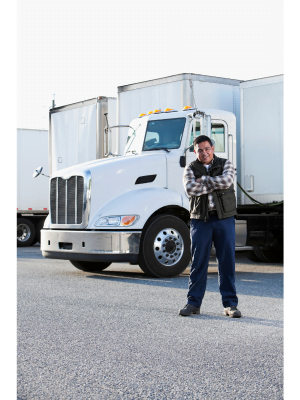Max Your Meal Claims: A Truck Driver's Guide in Canada
Picture this: you’re a truck driver in Canada, logging countless hours on the road. You know, every pit stop and diner from here to Timbuktu. But when it comes time to file taxes, you’re left scratching your head about meal claims.
We’ve got you covered. This manual delves into the specifics of meal expense claims for Canadian truckers, ensuring every penny is accounted for. Delving into the essentials and steering through tax deductions, we unfold everything you need to maximize your claims while adhering to CRA regulations.
Get ready to turn those meal receipts into real money back in your pocket while fully complying with tax laws. Embark with us on this adventure, transforming dry receipts into actual cash returns, all within the bounds of legality.

Understanding the Basics of Meal Claims for Canadian Truck Drivers
If you’re a truck driver in Canada, figuring out meal claims can feel like trying to solve a Rubik’s Cube. But it doesn’t have to be that complicated. Essentially, meal claims are tax deductions that allow you to get some money back for the meals you eat on the road.
The Canada Revenue Agency (CRA) has specific rules about who can claim these expenses and how much they can claim. As a truck driver, congratulations if you’re away from home for more than 12 hours or drive long-haul routes across provinces or into the United States. You’ve got a seat at the table (pun intended).
To start claiming your meal expenses, there’s one golden rule: keep those receipts. Whether it’s a dinner, breakfast, or fast food on the go, every bit counts towards lowering your taxable income. And let’s face it – saving money is always good news.
Maximizing Meal Claims for Truckers
Squeezing every penny out of your meal claims means understanding two methods approved by CRA: simplified and detailed tracking. The simplified method lets drivers claim a flat daily rate without keeping every receipt—convenient but might not capture all your spending.
Diving deep into detailed tracking, drivers who diligently archive every receipt can unlock the ability to claim their true expenditures, thus slicing through taxable income with precision.
Navigating Meal Deductions in Canada
Familiarize yourself with rates and limitations before embarking on this journey through paperwork. The standard deduction rate hovers around 80% of documented meal expenses while driving within Canada—a delicious figure. But cross-border journeys complicate things as different rates may apply. Check current guidelines because knowing exactly what applies gives clarity and potentially maximizes returns. A quick visit to CRA’s official website should give up-to-date information needed. Fuel up wisely—not just your rig but also your tax knowledge bank.
Maximizing Meal Claims for Truckers
Getting the most out of meal claims is like finding hidden treasure on a long-haul journey. Knowing the ins and outs can put extra cash in your pocket for Canadian truck drivers.
Navigating Meal Deductions in Canada
Unlocking the full potential of meal deductions hinges on grasping your rightful claims. The Canada Revenue Agency (CRA) allows truck drivers to claim 80% of their meal expenses while on the road. But here’s where it gets interesting: if you’re savvy about how these rules apply, especially when crossing into the U.S., this percentage could work more favorably due to currency exchange rates.
To ensure you get every dollar back, keep all receipts and meticulously log your days away from home. Digital apps can be lifesavers here, allowing easy tracking and categorization of expenses.
Tips for Claiming Meal Expenses as a Truck Driver
Filing taxes isn’t anyone’s idea of fun, but being smart about claiming meal expenses can lessen the pain. First, use digital tools or apps designed for truckers; they help track spending down to the last trip. Another pro tip? Pay attention to changes in tax laws each year by visiting the CRA website. Laws change, and staying updated means staying ahead.
Finally, it’s wise to chat with a tax expert who understands the specific financial intricacies faced by those behind the wheel of big rigs. They can offer tailored advice that might uncover additional savings or deductions you weren’t aware existed.
Understanding Canadian Per Diem Allowances
Per diem allowances offer an alternative route for claiming meals without keeping every receipt. The CRA sets standard rates that simplify record-keeping, but opting for actual expense claims often yields higher returns if done correctly. It boils down to personal preference: simplicity versus potential savings.
In any case, thorough documentation remains crucial whichever path you choose because if there’s one thing worse than missing out on deductions, it’s having those claims denied due to poor paperwork.
Navigating Meal Deductions in Canada
When claiming meal deductions, Canadian truck drivers have a unique set of rules they need to follow. No longer is it merely a matter of holding onto your receipts; rather, there exists an array of tactics to maximize your deductions legally.
Understanding Flat Rate vs Actual Cost Claims
 The first fork in the road is deciding between flat rate and actual cost claims. The Canada Revenue Agency (CRA) allows long-haul truck drivers to claim 80% of their meal expenses using either method, but choosing wisely could save you a bundle. Opting for flat rates transforms the hassle of hoarding every receipt into a more straightforward process of documenting expenses. However, if your meals often cost more than the daily allowance, tracking actual costs might put more money back in your pocket.
The first fork in the road is deciding between flat rate and actual cost claims. The Canada Revenue Agency (CRA) allows long-haul truck drivers to claim 80% of their meal expenses using either method, but choosing wisely could save you a bundle. Opting for flat rates transforms the hassle of hoarding every receipt into a more straightforward process of documenting expenses. However, if your meals often cost more than the daily allowance, tracking actual costs might put more money back in your pocket.
To use flat rates effectively, know what counts as a day away from home and how many meals that translates into for deduction purposes. On trips crossing international borders or extending beyond 24 hours within Canada’s vast expanses, this knowledge becomes critical for maximizing deductions without falling afoul of complex tax laws.
Tips for Maximizing Your Deductions
Audit-proofing your expense claims starts with habits like logging dates and locations alongside amounts spent or claimed at flat rates. While digital tools can help track these details accurately over time—saving headaches later during tax season—they only work if used consistently from day one.
Beyond mere compliance, though, lies opportunity: knowing when certain trips qualify for higher per diem rates due to cross-border regulations or other factors means more money retained from each paycheck—a vital boost given today’s rising living costs across Canada.
To wrap it up, by adopting these measures, we’re genuinely enhancing our chances for a brighter future. By focusing on precision and applying the right strategies, we’re setting ourselves up for success. Holding firm to our chosen route, we’re eager to discover the destinations it unfolds.
Tips for Claiming Meal Expenses as a Truck Driver
Knowing how to claim meal expenses smartly can save truck drivers a good chunk of change come tax time. Here’s the scoop on doing it right.
Keep Your Receipts Organized
To start, keeping receipts is your golden rule. But don’t just shove them in the glove compartment. Use an envelope or app designed for tracking expenses to keep things tidy and accessible. This makes life easier when filing taxes or if the Canada Revenue Agency (CRA) asks questions.
Having a neat setup for tracking not only aids in managing deductions but also illuminates your financial patterns, sometimes spotlighting opportunities to trim down expenses.
Understand What Qualifies
Not all meals are created equal in the eyes of CRA. To ensure your claims are above board, get familiar with what qualifies as deductible meal expenses according to CRA guidelines. Generally, meals consumed while away from home on long-haul trips qualify, but there are nuances worth noting.
Leverage Technology for Tracking
Harnessing the power of modern tech makes it a breeze to keep tabs on your dining costs while you’re hitting the road. Numerous apps offer features specifically tailored for truck drivers – enabling quick snaps of receipts and categorizing them accordingly without breaking a sweat.
- This saves heaps of time during tax season by having all information readily available at your fingertips,
- Making it less likely that you’ll miss out on deductions because something got lost in translation—or rather, in transportation.
Deducting Meals Using Simplified Method
You have two paths when calculating deductions: the simplified method or claiming actual costs. The simplified method lets you deduct a flat rate per meal to simplify record-keeping. But remember, this doesn’t mean ditching those receipts. You still need proof that these meals occurred.
Every dollar counts when you’re clocking miles across Canada. You can significantly boost your financial efficiency by diligently recording expenses and grasping the ins and outs of allowable write-offs. Keeping up with the latest tax regulations ensures you’re not missing out on savings as you journey through Canada.
Understanding Canadian Per Diem Allowances
When managing expenses on the road, Canadian truck drivers have a secret weapon: per diem allowances. This handy monetary device goes beyond merely boosting your bank balance; it’s designed to streamline the existence of those who spend a considerable chunk of their lives on the road.
The Basics of Per Diem Allowances
 A per diem allowance is a set amount given to truckers for meals and incidental expenses while traveling away from home. Unlike tracking every receipt, this flat rate makes life easier by cutting down paperwork and guesswork. Think of it as an all-you-can-eat buffet versus à la carte dining; one price covers everything within reason.
A per diem allowance is a set amount given to truckers for meals and incidental expenses while traveling away from home. Unlike tracking every receipt, this flat rate makes life easier by cutting down paperwork and guesswork. Think of it as an all-you-can-eat buffet versus à la carte dining; one price covers everything within reason.
The Canada Revenue Agency (CRA) sets specific rates that can be claimed without receipts, provided you meet their criteria. For current rates and conditions, visiting the CRA website gives you all the details straight from the horse’s mouth.
Making Claims Without Receipts?
Yes, you read that right. Truck drivers can claim meal expenses using these predetermined amounts without showing a pile of receipts at tax time. But there’s a catch – meticulous record-keeping is still crucial. You need to log where and when your trips took place because if the CRA knocks on your door with questions, “I forgot” won’t cut it as an answer.
This method saves time and lets you avoid tracking every coffee or snack bought on the go—a major plus during those long hauls across provinces or even into the US.
Difference Between Actual Expense Method & Simplified Method
If sifting through receipts sounds like your idea of fun (said no one ever), there’s always the actual expense method where every penny spent needs documentation—every gas station sandwich and roadside diner meal included. On the flip side stands a simplified method—our hero above—that uses fixed daily rates set by CRA.
This choice between methods depends largely upon personal preference or situation, but remember, simplicity often leads toward sanity, especially when dealing with taxes amidst tight schedules common among truckers today.
Making the Most of Meal Deductions in Canada
Truckers can snag some pretty sweet savings on their tax bills by smartly navigating the world of meal deductions. But like any good road trip, success lies in knowing the map and planning your stops wisely.
Understanding Canadian Per Diem Allowances
The Canadian Revenue Agency (CRA) offers a simplified method for claiming meal expenses through per diem allowances. This means instead of saving every receipt; you can claim a flat rate for each day you’re on the road. The current rate is $23 per meal, up to three meals daily. For more details on these rates and how they apply, visit the CRA’s guide for long-haul truck drivers.
Adopting this strategy streamlines the process, significantly reducing administrative tasks. However, don’t forget that keeping a detailed logbook of your travel days is crucial as proof of your claims, should the CRA ask.
Tips for Claiming Meal Expenses as a Truck Driver
To maximize your meal deductions effectively:
- Keep accurate records: Even if you opt for per diem allowances, maintaining an accurate logbook detailing dates and locations traveled is essential.
- Kick into high gear with technology: Use apps designed for truckers to help track expenses and mileage automatically; this makes record-keeping effortless.
- Become best friends with deadlines: Submitting tax returns late could mean penalties or missed opportunities to claim what’s rightfully yours.
Filing taxes might not be anyone’s idea of fun, but think about maximizing your meal deductions as finding extra cash under those seat cushions – it takes some effort but proves rewarding in the end.
Navigating Meal Deductions in Canada
Navigating tax laws may feel like reading a map upside down at first glance. Yet understanding which rules apply can turn tricky terrain into smooth sailing—or driving, rather.
Differentiating between personal meals and business-related dining is critical since only business-related meals are eligible for deduction. Furthermore, this distinction helps ensure compliance with CRA regulations, safeguarding against potential audits or disputes over claimed amounts.
Remember: exploring these strategies ensures you make the most out of available benefits, and adherence to guidelines provided by CRA will keep those financial gears running smoothly without hiccups along the way.
Simplifying Meal Claims for Truck Drivers
Regarding meal claims, truck drivers in Canada face a maze of rules and regulations. But fear not. With the right knowledge, navigating this terrain can become as effortless as cruising down a quiet highway.
Understanding the Basics of Meal Claims for Canadian Truck Drivers
Navigating through the CRA’s guidelines on meal expenses doesn’t have to be as daunting as crossing the Rockies in winter. First off, truck drivers are entitled to claim 80% of their meal expenses while on the road. This is because your cab becomes your “home away from home,” and let’s face it, cooking meals isn’t exactly practical while hauling goods across provinces.
Keep all receipts for food purchases during trips to ensure you’re claiming correctly. And remember, only meals consumed while working count; that celebratory dinner after returning home doesn’t qualify.
Maximizing Meal Claims for Truckers
Do you want every dollar back that you’re owed? Of course. Who wouldn’t? To do this effectively involves understanding two approaches: the actual expense method and the simplified method. The CRA offers both options, letting drivers choose the best based on their situation and record-keeping preferences.
The actual expense method requires meticulous receipt keeping but can pay off if your dining tends toward the pricier side or includes healthier options, often costing more than fast food. On the flip side (or should we say ‘the other lane’), there’s the simplified method – no need for receipts here; log those hours worked and apply CRA’s standard rate per meal period spent driving.
Tips for Claiming Meal Expenses as a Truck Driver
Last but not least, document everything like an award-winning novelist detailing their magnum opus. A detailed logbook with dates, locations, and reasons behind each stop will help validate your claims should any questions arise from the CRA downline – erasing potential headaches before they even begin.
Better yet? There are apps designed specifically for tracking these expenses automatically whenever you hit the road – turning what used to be a detailed process into a few simple taps screen at the end of the day. So why not take advantage of the tech tools available at your fingertips?
FAQs
How much can a Canadian truck driver claim for meals?
A trucker in Canada can claim 80% of their meal expenses using the simplified method or actual costs with receipts.
What are the CRA guidelines on meal allowance?
The CRA sets the meal allowance rate at $23 per meal, up to three meals daily. Truckers need to track days away.
How much can I claim for meals in Canada?
In general, Canadians can deduct 50% of eligible meal expenses. For truck drivers, it's bumped up to 80%.
What is meal allowance?
Meal allowance is a set amount of food each day while working. It simplifies expense claims and reduces paperwork.
